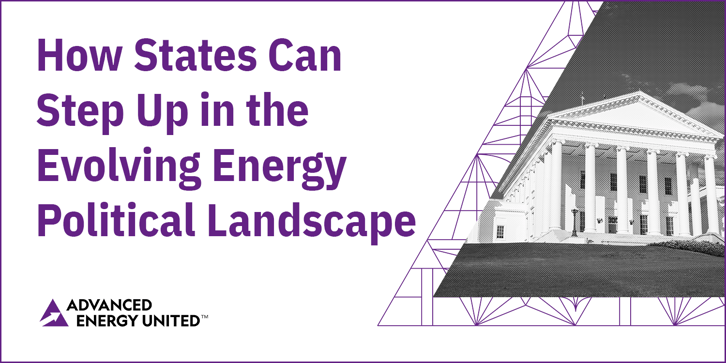
In 2025, the advanced energy sector faces uncertainty as changes in political leadership in Washington, D.C. raise concerns about shifting priorities in the federal agencies, and the potential for rollbacks of key policies within the Inflation Reduction Act (IRA) and other recent legislation.
To address how the advanced energy industry can sustain its momentum amidst these challenges, Advanced Energy United recently hosted a webinar entitled “Beyond the Ballot: Mapping State Clean Energy Strategies Post-Election.” Moderated by Jeff St. John, Director of News and Special Projects at Canary Media, the discussion featured insights from panelists Amisha Rai, Vice President of Advocacy at United; Harry Godfrey, Managing Director of Federal Investment and Manufacturing at United; and Kim Jemaine, Managing Director of the clean energy advocacy organization Counterspark.

A key theme of the discussion was the importance of state-level leadership and advocacy to speed the deployment of advanced energy solutions, particularly as the federal government’s priorities appear poised to change. Our panel highlighted several critical ways states can rise to meet the moment while navigating complex market dynamics, including:
- Advancing State-Specific Clean Energy Policies: States can implement policies tailored to their unique energy landscapes, such as adopting clean energy standards, improving energy infrastructure siting and permitting regimes, and supporting electric vehicle (EV) adoption with forward-thinking grid planning and incentives. Localized regulations and incentives can help spur innovation and investment.
- Protecting and Expanding Clean Energy Investments: States can continue to secure and expand investment in clean energy through legislative measures and executive actions that support renewable energy projects, energy storage, and infrastructure development. To start, states should take full advantage of the federal resources unlocked by the Bipartisan Infrastructure Law and IRA to help their residents save energy, transition to EVs, and build a more robust, resilient electric grid. Building on that, state leaders should lobby for the preservation of federal incentives, such as the tax credits in the IRA to ensure continued economic development from the clean energy sector. By combining the innovation, efficiency, and capital of the private sector with public policy leadership and regulatory oversight, public-private partnerships can create an ecosystem that accelerates clean energy solutions.
- Strengthening Regional Collaboration: States can collaborate regionally to address shared challenges, such as grid reliability, grid capacity, and energy affordability. This can involve working together to expand transmission infrastructure, procure and integrate large-scale renewable energy sources, and ensure coordinated energy planning.
- Enabling the Growth of Virtual Power Plants (VPPs): The policies that United has been advocating for over the past decade have helped fuel the deployment of distributed energy resources (DERs), from rooftop solar and smart thermostats to battery storage and EV charging. State policy can help unlock the deep value of these technologies by maximizing their use through the establishment of VPPs. State laws, regulations, and corresponding wholesale market rules are essential to creating operational VPPs.
- Supporting Energy Market Expansion: States can take steps to integrate energy markets, such as joining or forming regional transmission organizations (RTOs). This would facilitate greater access to clean energy, improve grid flexibility, and reduce energy costs. As an example, the panel pointed to Colorado Senate Bill 72, which established an independent transmission authority for the state, and mandates that investor-owned utilities join an RTO by 2030. Two energy markets have plans to expand in the Western U.S.
- Developing Workforce Training and Transition Plans: States can create training programs to help workers transition into clean energy jobs, focused on upskilling workers for positions in renewable energy sectors, energy efficiency, and clean technology innovation. States can harness economic development platforms to translate national industrial policy into local investment and job gains, as states have already been doing across the country.
Looking ahead, the 2025 and 2026 gubernatorial elections in key states, such as Virginia, will be critical for our industry’s growth. The outcomes will determine which leaders will champion—or oppose—the policies that shape the pace and success of our industry’s efforts in the years to come.
At the core of United’s work is a focus on maximizing the reach and impact of the advanced energy industry at the state level. As we navigate a changing political landscape, we remain committed to defending our industry both at the federal level in Washington, D.C. and through our deep engagement across states of all political persuasions.
Next week, we look forward to gathering leaders from our membership, alongside industry leaders, policymakers, and advocacy experts, at our Leadership Forum outside of our nation's capital to discuss our path forward. One of the highlighted panel sessions at the forum, "Political and Policy Outlook on Clean Energy in 2025," will explore strategies for building on our progress amidst increasing opposition, ensuring that advanced energy remains at the forefront of powering America's future. If you are interested in hearing this discussion and collaborating for a stronger advanced energy industry, we encourage you to inquire about membership to attend.
The energy transition faces big challenges in the years ahead– but, at United, we are determined to leverage our strengths and relationships to secure meaningful progress through advocacy and state engagement.
